
The Atlantic Ocean is the second-largest of the world's oceans, with an area of about 106,460,000 km2 (41,100,000 sq mi). It covers approximately 20 percent of Earth's surface and about 29 percent of its water surface area. It is known to separate the "Old World" from the "New World" in the European perception of the World.

The Caribbean Sea is an American mediterranean sea of the Atlantic Ocean in the tropics of the Western Hemisphere. It is bounded by Mexico and Central America to the west and south west, to the north by the Greater Antilles starting with Cuba, to the east by the Lesser Antilles, and to the south by the north coast of South America.

The walrus is a large flippered marine mammal with a discontinuous distribution about the North Pole in the Arctic Ocean and subarctic seas of the Northern Hemisphere. The walrus is the only living species in the family Odobenidae and genus Odobenus. This species is subdivided into two subspecies: the Atlantic walrus, which lives in the Atlantic Ocean, and the Pacific walrus, which lives in the Pacific Ocean.

Cod is the common name for the demersal fish genus Gadus, belonging to the family Gadidae. Cod is also used as part of the common name for a number of other fish species, and one species that belongs to genus Gadus is commonly not called cod.

The Atlantic cod is a benthopelagic fish of the family Gadidae, widely consumed by humans. It is also commercially known as cod or codling. Dry cod may be prepared as unsalted stockfish, and as cured salt cod or clipfish.
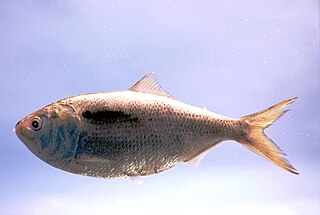
Menhaden, also known as mossbunker and bunker, are forage fish of the genera Brevoortia and Ethmidium, two genera of marine fish in the family Clupeidae. Menhaden is a blend of poghaden and an Algonquian word akin to Narragansett munnawhatteaûg, derived from munnohquohteau, referring to their use of the fish as fertilizer. It is generally thought that Pilgrims were advised by Tisquantum to plant menhaden with their crops.

Mackerel is a common name applied to a number of different species of pelagic fish, mostly from the family Scombridae. They are found in both temperate and tropical seas, mostly living along the coast or offshore in the oceanic environment.
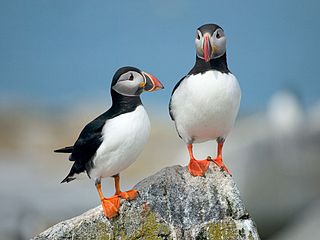
Puffins are any of three species of small alcids (auks) in the bird genus Fratercula with a brightly colored beak during the breeding season. These are pelagic seabirds that feed primarily by diving in the water. They breed in large colonies on coastal cliffs or offshore islands, nesting in crevices among rocks or in burrows in the soil. Two species, the tufted puffin and horned puffin, are found in the North Pacific Ocean, while the Atlantic puffin is found in the North Atlantic Ocean.

Clam is a common name for several kinds of bivalve molluscs. The word is often applied only to those that are edible and live as infauna, spending most of their lives halfway buried in the sand of the seafloor or riverbeds. Clams have two shells of equal size connected by two adductor muscles and have a powerful burrowing foot. They live in both freshwater and marine environments; in salt water they prefer to burrow down into the mud and the turbidity of the water required varies with species and location; the greatest diversity of these is in North America.

Swordfish, also known as broadbills in some countries, are large, highly migratory, predatory fish characterized by a long, flat, pointed bill. They are a popular sport fish of the billfish category, though elusive. Swordfish are elongated, round-bodied, and lose all teeth and scales by adulthood. These fish are found widely in tropical and temperate parts of the Atlantic, Pacific, and Indian Oceans, and can typically be found from near the surface to a depth of 550 m (1,800 ft), and exceptionally up to depths of 2,234 m. They commonly reach 3 m (9.8 ft) in length, and the maximum reported is 4.55 m (14.9 ft) in length and 650 kg (1,430 lb) in weight.

Right whales or black whales are three species of large baleen whales of the genus Eubalaena: the North Atlantic right whale, the North Pacific right whale and the Southern right whale. They are classified in the family Balaenidae with the bowhead whale. Right whales have rotund bodies with arching rostrums, V-shaped blowholes and dark gray or black skin. The most distinguishing feature of a right whale is the rough patches of skin on its head, which appear white due to parasitism by whale lice. Right whales can grow up to more than 18 m (59 ft) long with a highest-recorded length of 19.8 m (65 ft). Right whales are very robust whales, weighing 100 short tons or more. The largest known right whales can attain 20.7 m (68 ft) in length and weigh up to 135,000 kg (298,000 lb) or 21.3 m (70 ft) with uncertainty, Their immense bulk makes right whales significantly heavier than other whales of similar or greater length such as the humpback, gray, sperm and even fin whales. In fact, right whales rank only behind the blue whale in sheer body mass. One (apocryphal) explanation for their name is that whalers identified them as the "right" whale to kill on a hunt due to the plentiful oil and baleen they could provide.

Humpback dolphins are members of the genus Sousa. These dolphins are characterized by the conspicuous humps and elongated dorsal fins found on the backs of adults of the species. They are found close to shore along the coast of West Africa and right along the coast of the Indian Ocean from South Africa to Australia. Several institutions have made a proposal to divide the Indo-Pacific species into two distinct species: the Indo-Pacific humpback dolphin and the Australian humpback dolphin.

The Atlantic spotted dolphin is a dolphin found in the Gulf Stream of the North Atlantic Ocean. Older members of the species have a very distinctive spotted coloration all over their bodies.

The Atlantic Forest is a South American forest that extends along the Atlantic coast of Brazil from Rio Grande do Norte state in the northeast to Rio Grande do Sul state in the south and inland as far as Paraguay and the Misiones Province of Argentina, where the region is known as Selva Misionera.

The Atlantic bluefin tuna is a species of tuna in the family Scombridae. It is variously known as the northern bluefin tuna, giant bluefin tuna [for individuals exceeding 150 kg (330 lb)], and formerly as the tunny.

The Atlantic salmon is a species of ray-finned fish in the family Salmonidae. It is the 3rd largest of the Salmonidae and can grow up to a meter in length. Mongolian Taimen, and Pacific Chinook Salmon can be larger, with Taimen reportedly able to grow to 6ft long. It is found in the northern Atlantic Ocean and in rivers that flow into this ocean. Most populations of this fish species are anadromous, hatching in streams and rivers but moving out to sea as they grow where they mature, after which the adult fish seasonally move upstream again to spawn.
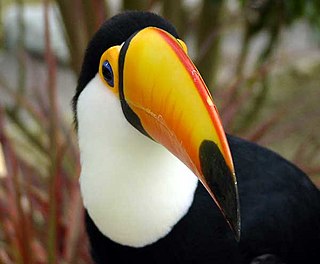
The wildlife of Brazil comprises all naturally occurring animals, plants, and fungi in the South American country. Home to 60% of the Amazon Rainforest, which accounts for approximately one-tenth of all species in the world, Brazil is considered to have the greatest biodiversity of any country on the planet. It has the most known species of plants (55,000), freshwater fish (3,000), and mammals. It also ranks third on the list of countries with the most bird species (1,832) and second with the most reptile species (744). The number of fungal species is unknown but is large. Approximately two-thirds of all species worldwide are found in tropical areas, often coinciding with developing countries such as Brazil. Brazil is second only to Indonesia as the country with the most endemic species.
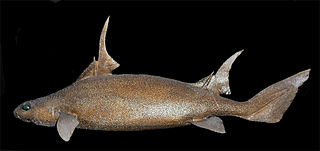
The sailfin roughshark is a species of dogfish shark in the family Oxynotidae, found in the eastern North Atlantic from Scotland to Senegal between latitudes 61°N and 11°N, at depths of between 265 and 720 m. Its length is up to 1.2 m (3.9 ft).
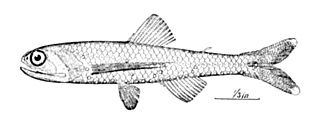
Lepidophanes is a genus of lanternfishes found in the Atlantic Ocean.

Lepidophanes gaussi, known as Günther's lanternfish, is a species of lanternfish distributed in the Atlantic Ocean between about 45°N and 50°S.


















